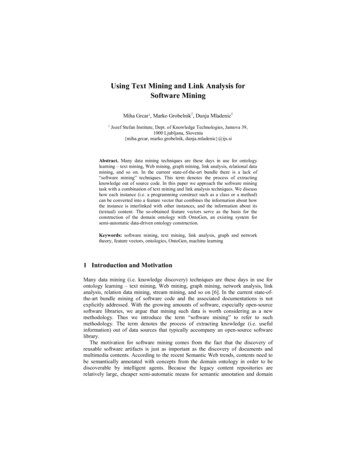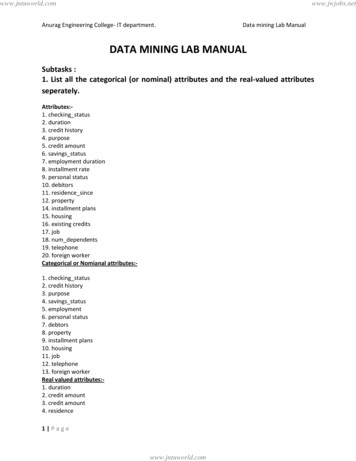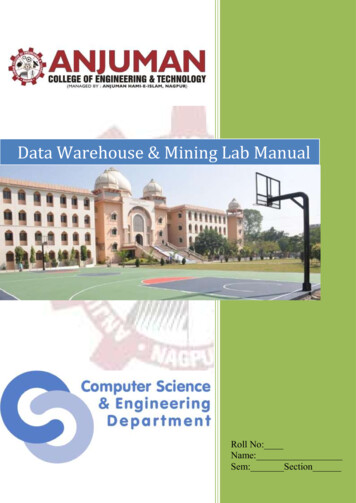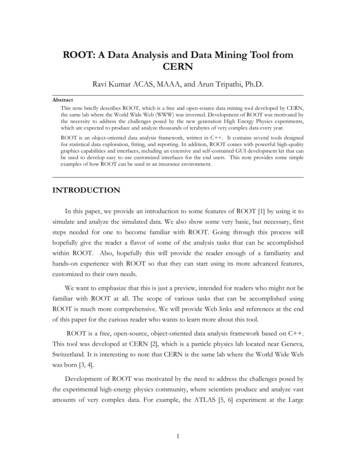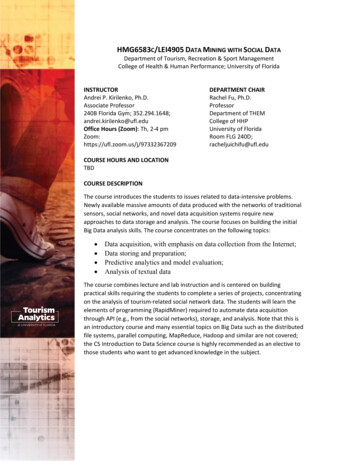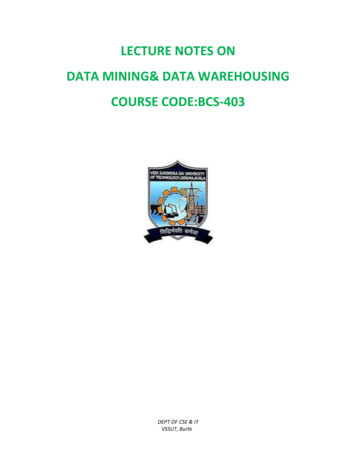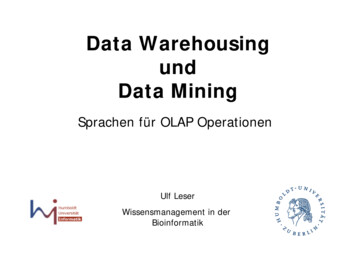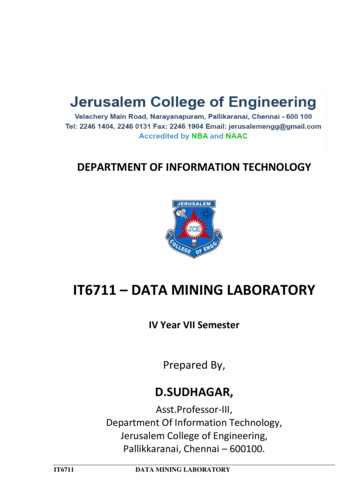
Transcription
DEPARTMENT OF INFORMATION TECHNOLOGYIT6711 – DATA MINING LABORATORYIV Year VII SemesterPrepared By,D.SUDHAGAR,Asst.Professor-III,Department Of Information Technology,Jerusalem College of Engineering,Pallikkaranai, Chennai – 600100.IT6711DATA MINING LABORATORY
Jerusalem College of EngineeringDepartment of ITCONTENTSExpt.noDateName of the Experiment1.Creation of a Data Warehouse.2.Apriori Algorithm.3.FP-Growth Algorithm.4.K-means clustering.5.One Hierarchical clustering algorithm.6.Bayesian Classification.7.Decision Tree.8.Support Vector Machines.9.Applications of classification for webmining.10.Case Study on Text Mining.IT6413Page.noDATA MINING LABORATORY1
Jerusalem College of EngineeringEx no: 1Date:Department of ITCREATION OF A DATA WAREHOUSE(Using ETL Tool – Extract -Transform-Load)AIM:To create a data warehouse from various .csv files using Postgrsql tool.WHAT IS A DATA WAREHOUSE?Data warehouse databases are designed for query and analysis, not transactions. The datathat is collected from various sources is separated into analytic and transaction workloads whileenabling extraction, reporting, data mining and a number of different capabilities that transformthe information into actionable, useful applications.The main data warehouse structures listed are the basic architecture, which is a simple setup that allows end-users to directly access the data from numerous sources through thewarehouse, a second architecture is a warehouse with a staging area that simplifies warehousemanagement and helps with cleaning and processing the data before it is loaded into thewarehouse. And finally there is the architecture with both a staging area and a data mart. Datamarts are used to create and maintain custom categories in organizations with specializeddatabase designed for specific businesses, so for example if an organization had a data warehousefor sales, separate from advertising, then the data mart setup would best serve their needs. Tofurther understand a data warehouse, it is important to look at its characteristics, which aresubject orientation, integration, non-volatility, and time variance.Subject Oriented: This refers to when data is giving information on a particular subject.For example, a company could use data to analyze their company‘s marketing data, and it‘seffectiveness. The devotion of a data warehouse to a specific matter is the key componentof a subject-oriented warehouse.Integrated: This is when data gathered from a number of disparaging sources, and then allgathered into a coherent whole. By organizing differing data into consistent formats,companies can resolve problems and inconsistencies among units of measurement andpromote better results.Nonvolatile: This refers to data that remains stable and unaffected by new developments.Once entered into the system, this data should not change, ensuring comparison analysisover a long period of time.Time Variant: This refers to data gathered is identified with a particular time period andfocuses on change over time. By using a large amount of data, spread over a long timeIT6413DATA MINING LABORATORY2
Jerusalem College of EngineeringDepartment of ITperiod, analysts can decipher patterns, and business relationships that would haveotherwise been overlooked.DATA WAREHOUSE INTEGRATION PROCESSThe whole purpose of data mining is to facilitate business analysis. And to accomplishthis, raw data must be arranged and consolidated into an information base usable by the firm.This process is referred to as ETL (Extract, Transform, & Load), which though it may seem likespecified steps, is in opposition referring to a broader concept.EXTRACTIONThis step in the process refers to removing the data from its source and making itaccessible for further processing. All the needed data is retrieved without affecting the sourcesystem‘s performance, response time or locking in a negative manner. This first step in the ETLprocess usually involves a cleaning phase in which data quality is ensured through dataunification. The rules of unification should include things such as making identifiers unique suchas gender categories, phone number, and zip code conversions into standard form and validationof address fields converted into the proper format.TRANSFORMATIONThis step applies a set of rules to change source data into similar dimensions so the sameunits of measurement can be used. This transformation step also joins data from a variety ofsources, generates aggregates, surrogate keys and applies validation and new values.LOADINGThe loading phase is a two-part process of disabling constraints and indexes before theload process starts and then enables them once the load is completed. In this step, the target of theload process is often a database.SETTING UP A DATA WAREHOUSEThe main purpose of a data warehouse is to organize large amounts of stable data to beeasily retrieved and analyzed. So when setting up, care must be taken to ensure the data is rapidlyaccessible and easily analyzed. One way of designing this system is with the use of dimensionalmodeling, which allows large volumes of data to be efficiently queried and examined. Sincemuch of the data in warehouses is stable, that is, unchanging, there is hardly a need for repetitivebackup methods. Also, once new data is loaded it can be updated and backed up right away byway of, in some cases, the data preparation database, so it becomes available for easy access.There are four categories of data warehousing tools; these are extraction, table management,query management and data integrity tools. All these tools can be used in the setup andIT6413DATA MINING LABORATORY3
Jerusalem College of EngineeringDepartment of ITmaintenance of the best technology to manage and store the huge amounts of data a companycollects, analyzes and reviews.COMPANY ANALYSISThe first step, in setting up the company‘s data warehouse, is to evaluate the firm‘sobjectives, For example, a growing company might set the objective to engage customers inbuilding rapport. By examining what the company needs to do to achieve these tasks, what willneed to be tracked, the key performance indicators to be noted and a numeric evaluation of thecompany‘s activities the company can note and evaluate where they need to get started.EXISTING SYSTEM ANALYSISBy asking customers and various stakeholders pointed questions, Business Intelligenceleaders can gather the performance information they currently have in place that is or isn‘teffective. Reports can be collected from various departments in the company, and they may evenbe able to collect analytical and summary reports from analysts and supervisors.INFORMATION MODELING OF CORE BUSINESS PROCESSESAn information model is conceptual, and allows for one to form ideas of what businessprocesses need to be interrelating and how to get them linked. Since the data warehouse is acollection of correlating structures, creating a concept of what indicators need to be linkedtogether to create top performance levels is a vital step in the information modeling stage. Asimple way to design this model is to gather key performance indicators into fact tables and relatethem to dimensions such as customers, salespeople, products and such.DESIGN AND TRACKOnce all those concepts are set in place, the next critical step is to move data into thewarehouse structure and track where it comes from and what it relates to. In this phase of design,it is crucial to plan how to link data in the separate databases so that the information can beconnected as it is loaded into the data warehouse tables. The ETL process can be pretty complexand require specialized programs with sophisticated algorithms, so the right tools have to bechosen at the right, and most cost effective price for the job. Because the data is to be trackedover time, the data will need to be available for a very long period. However the grain (atoms ormake up) of the data will defer over time, but the system should be set that the differinggranularity is still consistent throughout the singular data structure.IMPLEMENTATION OF THE PLANOnce the plan is developed, there is a viable basis for scheduling the project. Because theproject is grand, there should be phases of completion scheduled and then fit together uponIT6413DATA MINING LABORATORY4
Jerusalem College of EngineeringDepartment of ITcompletion. With careful planning, the system can provide much-needed information on howfactors work together to help the organizations activities.UPDATESSince the data warehouse is set to retain data for long stretches at many levels ofgranularity and has already been set to be consistent throughout the system, in the design phaseof the warehouse setup, there can be various storage plans that tie into the non-repetitive update.As an example, an IT manager could set up a week and monthly grain storage systems. In the daygrain, data is stored in its original format for 2-3 years, after which it is summarized and movedto the weekly grain structure where it could remain for another 3-5 years and then finally to amonthly grain structure. This can all be set at the design phase to work with the different grainsbased on data age and be done automatically.DATA WAREHOUSE COMPONENTSSo as was the case in the design and set up phase of the warehouse, data was merged fromvarying sources into a single related database. And so far we have seen that the point of creatingthis warehouse structure is to retrieve information faster and more easily so a firm can marketfaster, create more revenue, improve service standards and manage industry changes.LOAD MANAGEMENTLoad management refers to the collection of information from varying internal andexternal sources and summarizing, manipulating and changing the data into a format that allowsfor analysis. To manage the load, raw data must be kept along with the changed versions toenable construction of different representations as needed.WAREHOUSE MANAGEMENTWarehouse management is the day-by-day management of a data warehouse that ensuresthe information is available and effectively backed up and secure.QUERY MANAGEMENTQuery management allows access to the warehouse contents and may even include thetasks of separating information into various categories to be presented to different users. Usersmay access information through query tools or custom built applications.DATA WAREHOUSE BACKUP, STORAGE & TOOLSLike any other program, data warehouses can be tedious to design create and implement,so special measures should be in place to ensure the information is not lost.BACKUP AND RESTORATIONAn automatic system should be put in place to ensure the information is secure and that ifneeded data can be restored quickly and with little or no negative alterations. The first and mostvital step is to ensure the original information source is backed up and then following that aIT6413DATA MINING LABORATORY5
Jerusalem College of EngineeringDepartment of ITweekly backup of the entire warehouse as it could prove costly to have to recreate the entiresystem from scratch. The use of cold and multiplexing backup systems will ensure less need forrestoration. However, a disaster recovery site should be made available for copies of all keysystem components. The simplest way to achieve this is using a system that automatically createscopies and sends them to the disaster site. But there are systems that can copy hybrid databasesystems and create the backup if that is needed as well.ONLINE AND OFFLINE STORAGEData storage should be done both online and offline to avoid overwhelming the system orhaving ―disk full‖ issues. With the system setup to store data in different granularity settings,one could stash older, raw data and unused or rarely used reports and multimedia offline. Theimplementation of hierarchical storage management (storing files automatically to a secondarysource while allowing users access) is a smart move after implementing the data warehousesetup.STORAGE TOOLSThere are a few tools being created to rectify the storage issues that occur with data warehouses.Storage Manager takes care of all the storage objects such as file systems, database,network intelligence devices and disk and tape arrays. This system also collects data aboutdata, performs administrative duties and among other things let you see the health of yourdata warehouse.Storage Optimizer is another product that can be used for recommendations of actionsthat will remove hot spots and improve online performance and reliability. It will alsoinclude actions to take for offline storage based on historical patterns.Storage Planner enables planning for large online and offline database capacity. Thisprogram focuses on large, international databases and warehouses.IT6413DATA MINING LABORATORY6
Jerusalem College of EngineeringDepartment of ITCreate Data Warehouse using Postgresql tool (ETL Tool)STEPS:1.Click Start –AllPrograms – PostgreSQL 9.3 – click pgAdmin III2.Click this icon3.Enter name, host, password is postgres.IT6413DATA MINING LABORATORY7
Jerusalem College of EngineeringDepartment of IT4. Double click sudhagar(localhost:5432)5.Right click -databases(1) and choose - new database and type database nameIT6413DATA MINING LABORATORY8
Jerusalem College of EngineeringDepartment of IT6.Double click dwftp and click scemas(1) – right click – select new schema - typeschema name.7.Double Click dw – tables(0) - Click icon – SQL - Type query and click run icon.IT6413DATA MINING LABORATORY9
Jerusalem College of EngineeringIT6413DATA MINING LABORATORYDepartment of IT10
Jerusalem College of EngineeringDepartment of IT8.Then close SQL query dialog box.IT6413DATA MINING LABORATORY11
Jerusalem College of EngineeringDepartment of IT9.Upto above we created database along with primary key. Next we Import .csv file and storedata in the databases.- Gototables – choose table name and right click - choose Import option.- Then
IT6413 DATA MINING LABORATORY 6 weekly backup of the entire warehouse as it could prove costly to have to recreate the entire system from scratch. The use of cold and
